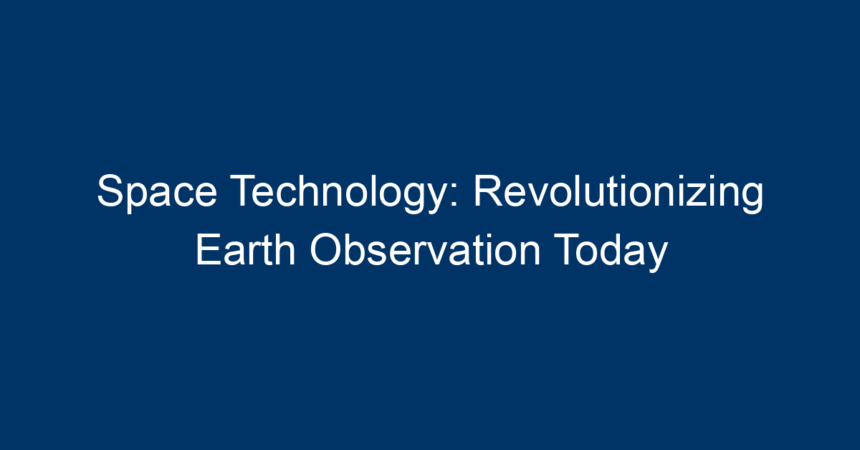Introduction
In an age where climate change, urbanization, and natural disasters dominate the headlines, the significance of space technology in earth observation has never been more apparent. From monitoring environmental changes to disaster response, advancements in space technology are transforming how we perceive and interact with our planet. This article delves into the latest developments in space technology, exploring how they are revolutionizing earth observation and the implications for our future.
Understanding Space Technology
What is Space Technology?
Space technology encompasses a wide array of systems, services, and equipment that are designed for activities beyond Earth’s atmosphere. This includes satellite systems, space exploration missions, and various sensors designed for data collection. As technology evolves, it enables us to gather more precise data about our planet, leading to innovations in various fields like meteorology, agriculture, and urban planning.
Key Components of Space Technology in Earth Observation
-
Satellites: Satellites equipped with high-resolution imaging capabilities provide invaluable data for mapping urban areas, monitoring agricultural conditions, and assessing natural disaster impacts.
-
Remote Sensing: This technology allows for the collection of data from a distance, using sensors that capture electromagnetic radiation reflected or emitted from the Earth’s surface.
-
Geographic Information Systems (GIS): GIS integrates various data sets, allowing for comprehensive analysis and visualization, which plays a crucial role in urban planning and environmental management.
- Drones: Unmanned aerial vehicles (UAVs) offer a cost-effective method for collecting data over local areas, especially where satellite data may lack precision.
The Role of Space Technology in Earth Observation
Climate Monitoring
One of the most crucial applications of space technology is climate monitoring. Satellites equipped with advanced sensors can track atmospheric conditions, sea level rises, and land use changes in real-time. For instance, NASA’s Earth Observing System satellites collect data that is critical for climate models, enabling scientists to predict changes and develop mitigation strategies.
Disaster Management
Space technology is a game changer in disaster management. Satellite imagery aids in early warning systems for hurricanes, floods, and wildfires, helping to save lives and minimize property damage. Post-disaster, high-resolution satellite images allow for rapid damage assessment and recovery efforts. For example, after natural disasters, agencies can quickly evaluate affected areas, enabling faster responses.
Agriculture and Food Security
With a growing global population, food security is a pressing concern. Space technology enhances agricultural practices through precision farming techniques. Satellites provide farmers with data on soil moisture, crop health, and pest infestations, allowing for more efficient resource allocation. By harnessing this technology, farmers can increase yields while minimizing waste, contributing to sustainable practices.
Urban Planning and Management
As cities expand, urban planning becomes increasingly complex. Space technology facilitates the monitoring of urban growth patterns, traffic management, and infrastructure development. GIS and satellite imagery help city planners make data-driven decisions, optimizing land use and enhancing the quality of life for residents.
Environmental Protection
The health of our planet is directly tied to the effectiveness of conservation efforts. Space technology plays a vital role in monitoring deforestation, loss of biodiversity, and pollution levels. Satellite observations allow organizations to oversee protected areas and enforce environmental laws. This data is crucial for both national and global initiatives aimed at sustainable development.
Key Innovations in Space Technology
Small Satellites (CubeSats)
The advent of small satellites, or CubeSats, has made space accessible like never before. These miniaturized satellites are cost-effective and can be deployed in swarms, providing high-resolution data with minimal financial investment. Universities and startups are increasingly using CubeSats for earth observation missions, democratizing access to space technology.
Artificial Intelligence and Machine Learning
Artificial intelligence (AI) and machine learning are transforming data analysis in earth observation. These technologies can process vast amounts of satellite data, identifying patterns and anomalies that human analysts might miss. For instance, AI algorithms can predict crop yields by analyzing climate and land-use data, helping farmers make informed decisions.
Internet of Things (IoT) Integration
IoT devices are becoming integral to earth observation, allowing for real-time data collection from the ground level. When combined with satellite data, IoT enables more comprehensive environmental monitoring. For example, sensors placed in forests can detect changes in temperature and humidity, providing essential data to satellites monitoring deforestation.
The Future of Earth Observation
International Collaboration
The importance of global collaboration in space technology cannot be understated. Initiatives such as the European Space Agency’s Copernicus program and NASA’s Global Precipitation Measurement mission exemplify how multiple countries can work together to advance earth observation capabilities. As challenges like climate change and natural disasters become increasingly global, joint efforts are essential.
Enhanced Data Accessibility
With advancements in cloud technology, data accessibility will continue to improve. Open data initiatives are allowing researchers, policymakers, and the public to access crucial satellite data. This democratization of information empowers communities to make informed decisions based on real-time observations.
Ethical Considerations
As space technology continues to evolve, ethical considerations will play a critical role. Issues such as data privacy, military applications of satellite technology, and the environmental impact of launching satellites require ongoing dialogue and regulation.
Conclusion
The revolution in space technology is fundamentally changing how we observe and interact with Earth. Through advanced satellites, remote sensing, and innovative tools like AI and IoT, we are better equipped to address some of humanity’s most pressing challenges. As we continue to explore the cosmos, the data gathered will empower us to create a more sustainable and resilient future.
Actionable Insights
-
Stay Informed: Follow developments in space technology to understand their implications for various sectors.
-
Leverage Open Data: Utilize accessible satellite data for research, teaching, or even personal projects in environmental awareness.
-
Promote Collaboration: Encourage partnerships between government, academia, and the private sector to harness the full potential of space technology for earth observation.
- Advocate for Ethical Practices: Engage in discussions about the ethical implications of space technology to ensure responsible use.
By embracing these insights, we can collectively contribute to a more informed and proactive approach towards our planet’s health and sustainability.




